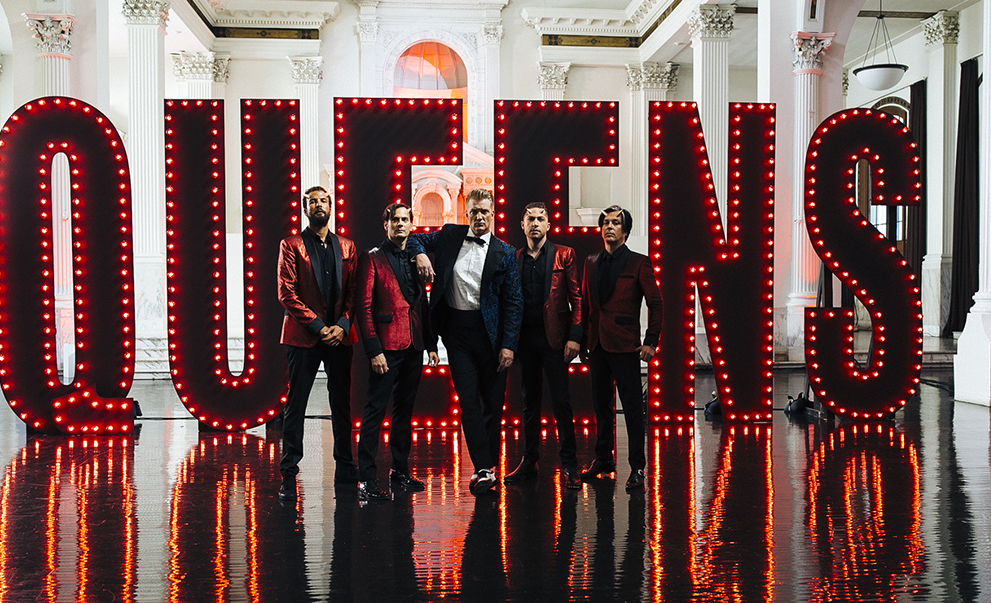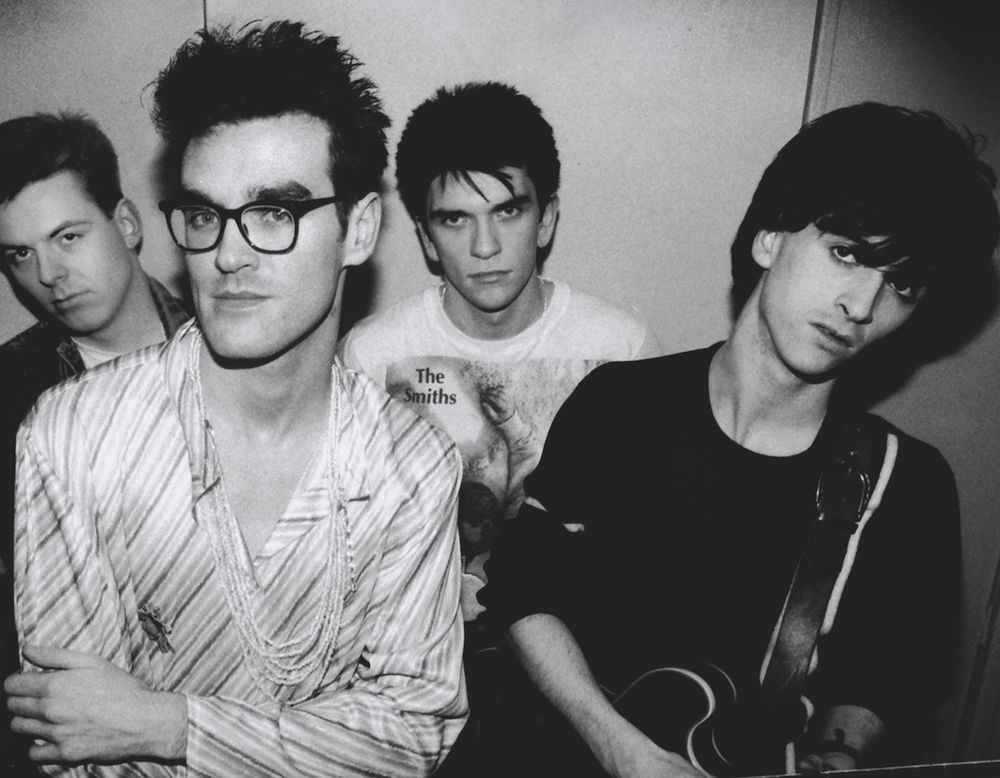It's been 20 years since Josh Homme breathed new life into the ashes of his old band, the seminal stoner metal outfit Kyuss, thereby conceiving Queens Of The Stone Age: one of the most successful, forward-thinking (not to mention badass) hard-rock groups of the new millennium. As the most high-profile product of Joshua Tree, CA’s so-called "desert rock" community -- a sun-baked, stoner-friendly approach to ‘70s riff-rock spearheaded by Homme and his fellow desert-dwellers -- the Queens inherited, and initially accepted, the role of de facto scene ambassadors.
However, as their subversive name suggests, Homme's true aims with Queens Of The Stone Age lay in challenging the stylistic and thematic trappings of their chosen genre, rather than kowtowing to them. We've got the man's unparalleled collaborative streak to thank for that; no two incarnations of the band have been exactly the same, and while Homme is undeniably Queens Of The Stone Age’s anchor, he's also an eager collaborator, as exemplified by QOTSA's extensive cast of current and former players (Homme's ex-Kyuss comrades Nick Oliveri and Alfredo Hernández; head Foo Fighter and ex-Nirvana drummer Dave Grohl; and Screaming Trees crooner Mark Lanegan, to name a few) and side projects (Eagles Of Death Metal, Desert Sessions, Them Crooked Vultures).
[articleembed id="1958058" title="Premature Evaluation: Queens Of The Stone Age Villains" image="1958512" excerpt="Villains isn’t the best album QOTSA album, but it’s at least their most immediately lovable since Songs For The Deaf. "]
This abundance of fresh blood, coupled with Homme's willingness to subvert hard-rock orthodoxy through melody and wit, has paid off in commercial and critical dividends throughout the Queens' three-decade existence, which can be divided, roughly, into three main periods: their primordial, Kyuss-y days (1998's Queens Of The Stone Age, 2000's R, 2002's Songs For The Deaf); their melodic uptick in the mid-aughts, spawned by Oliveri's 2004 departure (2005's Lullabies To Paralyze, 2007's Era Vulgaris); and the band's present period of pop-leaning maximalism, which began with 2013's ...Like Clockwork LP and continued last week with the excellent Villains. Here's a primer of Homme and company's most infamous -- that is to say, greatest -- songs.
10. “Feet Don’t Fail Me” (from Villains, 2017)
A desert-rock origin story masquerading as Led Zep boogie machine, the opening track from Queens Of The Stone Age's new Mark Ronson-produced album, Villains, offers the perfect introduction to the band's carnivalesque insanity and, perhaps more importantly, the devilish impresario calling all the shots. "I was born in the desert, May 17 in '73," croons Homme, going on to proffer up his group's mission statement: "When the needle hit the groove, I commence to moving/ I was chasing what's calling me." The track's gravitas validates the frontman accordingly, taking a roiling rhythm as far as it can go, and then some.
[videoembed size="full_width" alignment="center"][/videoembed]
9. “You Can’t Quit Me, Baby” (from Queens Of The Stone Age, 1998)
Before their dalliances in ornate orchestral pop and nocturnal disco, Queens Of The Stone Age were, for all intents and purposes, a jam band. With their riff-centric foci and ample instrumental breaks, the tracks comprising 1998's eponymous debut have more in common with the Grateful Dead than, say, the Foo Fighters -- least of all "You Can't Quit Me, Baby," a glassy-eyed slow burner which employs a leaden, chugging bass riff as the platform for Homme's stalker playacting ("Followed you home/ But you were not there/ Slashed and I cut/ And I bled in the sink"). As its nearly seven-minute runtime slithers on, encircling the main motif like a serpent, so does the psychotic break, culminating in a spectacular and self-destructive finale.
[videoembed size="full_width" alignment="center"][/videoembed]
8. “3’s And 7’s” (from Era Vulgaris, 2007)
Released in 2007, Era Vulgaris is the bucking, bratty, black sheep of the Queens discography. Homme and company took a break from sweeping melodrama, doubling down on the robotic riffage instead. As if to underscore its complete lack of subtlety, the frontman has described the record, alternately, as "dark, hard, and electrical, sort of like a construction worker," and "like dirt, clearly seen." True to his description, the album's ricocheting ode to little white lies, "3's And 7's," pulls no pretty punches; instead, the band takes the gritty with the groovy to great, even cartoonish effect, leaving us with one hell of a smoldering molotov cocktail.
[videoembed size="full_width" alignment="center"][/videoembed]
7. “You Think I Ain't Worth A Dollar, But I Feel Like A Millionaire” (from Songs For The Deaf, 2002)
If Josh Homme is Queens' Dr. Jekyll, then bassist/vocalist Nick Oliveri -- a former member of Kyuss and the Dwarves, who contributed to R and Songs For The Deaf -- is Mr. Hyde, prone to fits of anger, intoxication, and onstage nudity. (That temper, and the incendiary conduct which frequently accompanied it, ultimately prompted Homme to kick him out of the band in 2004.) However steeped in controversy, Oliveri remains one of the band's most memorable assets, armed with a throat that could shatter glass and a penchant for fiery bass runs. We've got him to thank for the pedal-to-the-metal bloodlust coursing through Songs For The Deaf opener "You Think I Ain't Worth A Dollar, But I Feel Like A Millionaire;" when he begs the "toto" to "give him some more," you better get out of the way -- the storm's coming.
[videoembed size="full_width" alignment="center"][/videoembed]
6. “I Appear Missing” (from ...Like Clockwork, 2013)
In the early aughts, Josh Homme was at the end of his rope. Months of nonstop touring, recording, writing, and producing had taken their toll on the California native's psyche, and later, his body; Homme eventually ended up in the hospital with an antibiotic-resistant staph infection. Homme later recalled his close brush with death to comedian Marc Maron, framing it as an awakening: "I've always heard music in my head since I was a little kid, and I’ve just played at that," he said, "and when I woke up this time, I heard nothing for a couple of years -- I’d never been knocked down that hard." Such are the sullen trappings of 2013's majestic ...Like Clockwork, an album consumed by death and longing, and its crown jewel "I Appear Missing." Less a song than a film noir in musical form, the spindly ballad takes a wrecking ball to Queens' (and by extension, Homme's) devil-may-care attitude, constructing a daring monument to vulnerability, rather than brute force.
[videoembed size="full_width" alignment="center"][/videoembed]
5. “In The Fade” (from R, 2002)
No Queens countdown would be complete without mentioning “In The Fade,” R’s stoner rock wonderland presided over by Screaming Trees frontman (and longtime Homme associate) Mark Lanegan. Here, the band’s collaborative prowess transcends creative co-mingling, instead coalescing into the stoner rock equivalent of a slack meditation, presented by way of four stabbing syllables: “Live till you die.” Lanegan’s smoky, full-bodied baritone forms the perfect complement to Homme’s ghostly falsetto; as their sinister threads intertwine, so do the shadows, leaving us with one hell of a churning soundscape (emphasis on the hell).
[videoembed size="full_width" alignment="center"][/videoembed]
4. “In My Head” (from Lullabies To Paralyze, 2005)
Queens' pop prowess takes center stage on this gem off 2005's Lullabies To Paralyze, the band's fairytale-inspired journey into the heart of darkness. Having fired Oliveri shortly before the LP's sessions started, the group found themselves in a state of creative flux. Rather than scramble for a substitute, Homme doubled down on poptimism, spiking the band's molten template with cool, quipped new wave. Powered by the best jagged riff the Cars never wrote, propelled by spirited, staccato piano plunks and swirling counter-melodies, "In My Head" remains one of the band's greatest triumphs, even more than its cowbell-centric lead single "Little Sister." Why? Because it's damn ballsy, that's why.
[videoembed size="full_width" alignment="center"][/videoembed]
3. “The Lost Art Of Keeping A Secret” (from R, 2000)
The first single off R, “The Lost Art Of Keeping A Secret” gave Queens their first taste of fame, in the form of video airplay and modest chart success. It peaked at 21 on the mainstream rock charts -- not bad for a bunch of stoners drifting around a nü-metal scene. It’s also sonically stunning, a playground for stylistic juxtaposition: spritely bass against brittle xylophones; honeyed falsettos against fanged, Motörhead-flavored breakdowns; the old dynamic force against developing wit. Whatever you do, don’t tell anyone -- just listen.
[videoembed size="full_width" alignment="center"][/videoembed]
2. “Go With The Flow” (from Songs For The Deaf, 2002)
Leave it to a sneering, chain-smoking lothario to write one of modern rock’s smartest, sexiest love songs. Songs For The Deaf's hit single is a turbo-charged paean to ephemeral passion, insatiable lust, and the bittersweet spaces in-between, filled to the brim with quotables (“She said I’ll throw my past away/ They’re just photos after all”; “I want something good to die for/ To make it beautiful to live”). Further intensifying the experience is drummer Dave Grohl, who hitches his percussive rampage to song’s anxious, incessant pianos, giving rise to a bona fide hard-rock hurricane.
[videoembed size="full_width" alignment="center"][/videoembed]
1. “A Song For The Deaf” (from Songs For The Deaf, 2002)
“Here is something you should drop to your knees for, and worship,” an unnamed DJ proclaims, introducing Songs For The Deaf’s title track. He’s not kidding -- the nearly seven-minute nightmare is easily Queens Of The Stone Age’s greatest sonic offering to date, a punishing composite of Homme et al’s greatest strengths.
You want riffs? Cower in fear before Oliveri’s deliriously mucky bass riff, which stomps out of the speakers like a cross-faded Godzilla, or Homme’s ominous, thunderstruck tremolos, aural toxins deeply embedded with song’s interstitial spaces. You want dirty hooks? Look no further than the chorus, all sun-kissed grandeur and dulcet sighs, pulp-fiction excess incarnate. You want kick-ass collaborations? Behold! Four horsemen (Homme, Oliveri, Lanegan, and Grohl) go scream-to-scream, blow-for-blow, and riff-for-riff, ushering in the apocalypse through collectively conjured chaos. You want the apocalypse? Here it is. And man, is it marvelous.
[videoembed size="full_width" alignment="center"][/videoembed]






